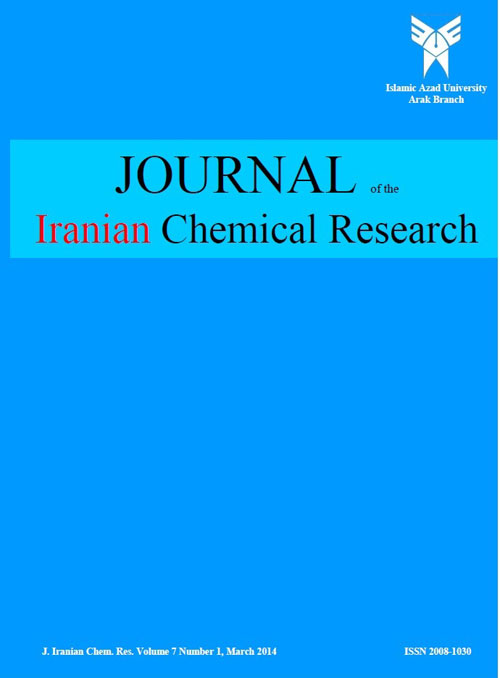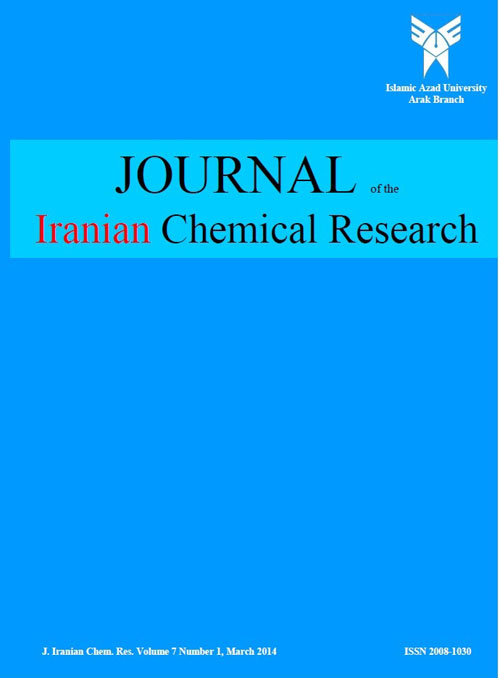فهرست مطالب

Journal of the Iranian Chemical Research
Volume:1 Issue: 1, Autumn 2008
- تاریخ انتشار: 1387/06/30
- تعداد عناوین: 9
-
Pages 1-10A simple and sensitive method is described for the pre-concentration by cloud point extraction followed by atomic absorption spectrometric determination of copper ion in real samples. At a solution pH of 5.5, 5, 5-diphenylimidazolidine-2, 4-dione (phenytoin) (DFID) and TritonX-114 were used as hydrophobic ligand and non-ionic surfactant. The adopted concentrations for DFID, Triton X-114 and HNO3, bath temperature, centrifuge rate and time were optimized. Detection limits (3SDb/m) of 1.7 ng mL-1 along with enrichment factors of 35 for these ions were achieved. The proposed procedure was applied to the analysis of real samples.Keywords: Cloud point extraction, Copper, Triton X, 114, Flame atomic absorption spectrometry
-
Pages 11-17An efficient one-pot condensation for the synthesis of 1,8-dioxo-octahydroxanthene is achieved through a condensation of aryl aldehydes and 5,5-dimethyl-1,3-cyclohexandione in the presence of NBS. This method enjoys several advantages such as low cost, simple work up procedure and safe reaction condition. In addition, water was chosen as a green solvent.Keywords: One, pot, NBS, 1, 8, dioxo, octahydroxanthene, Organocatalyst, Aqueous media
-
Pages 19-24In this research different types of Al2O3 were used as supports to prepare catalysts for dehydrogenation of isobutane to isobutene. These supports were Al2O3 from Merck, Axen and gamma Al2O3 synthesized from Al(OH)3. Sn/Pt/Al2O3 catalysts were prepared by sequential impregnation, at first Pt and then Sn was deposited. Characterization of catalysts was performed by X-ray powder diffraction (XRD) and thermal analysis (TG/DTG) techniques. Elemental analysis of the catalysts was also carried out by wet chemical analysis using inductively coupled plasma (ICP) technique. Isobutane dehydrogenation was studied in a reactor under atmospheric pressure at 848 K. The conversion, selectivity and yield of the prepared catalysts were calculated.Keywords: Bimetallic catalysts preparation, Supported platinum–tin catalysts, Dehydrogenation, Isobutene
-
Pages 25-32A simple, precise, rapid and low-cost potentiometric method for diclofenac determination in pharmaceuticals is proposed. A new diclofenac-sensitive electrode was constructed by incorporating the diclofenac ion pair complex with butyl rhodamine B into graphite matrix. The electrode exhibited a linear response over the concentration range of 1 × 10-4 5 × 10-2 mol L-1, a detection limit of 3.9×10-5 mol L-1 with a Nernstian slope of 61 ± 2 mV decade-1. The working pH range is 6-11. The electrode is easily constructed, has fast response time (3-11 s) and can be used for the period of six months without any considerable deterioration. The proposed sensor displays good sensitivity for diclofenac in the presence of several substances. It was used to assay diclofenac in pharmaceuticals.Keywords: Diclofenac, Potentiometry sensors, Pharmaceutical analysis
-
Pages 33-40A novel mathematical model has been developed to aid the formulation of emulsion explosives. This mathematical model calculated heat of explosion, oxygen balance and raw material cost as a function of explosive ingredients, and the solution of the mathematical model was obtained by a MS Excel program. The effects of the different content of NH4NO3, NaNO3, H2O, and span-80 and composite fuel oil on the heat of explosion and the specific volume of emulsion explosive were discussed based on the proposed mathematical model. The results show that (1) with the increasing of the content of NH4NO3, the heat of explosion and the specific volume increase. (2) The better content of NaNO3, H2O and Span-80 in the formulation of emulsion explosive are 7%~9%, 9%~10%, 1.5%~2% respectively, and this formulation results in an oxygen balance of zero or close to zero.Keywords: Mathematical Model, Emulsion explosive, Explosion, oxygen balance
-
Pages 41-50Acrylic-type polymeric systems having degradable ester bonds linked to ibuprofen were synthesized and evaluated as materials for drug delivery. Ibuprofen, as a non-steroidal anti-inflammatory drug, was linked to 2-hydroxyethyl methacrylate by activated ester methodology in one-pot procedure. The resulting methacrylic derivative of ibuprofen was copolymerized with 2-hydroxyethyl methacrylate and n-butyl acrylate (in 1:3 mole ratio) by free radical polymerization method in N,N-dimethylformamide solution, utilizing azoisobutyronitrile as initiator at 65-70 oC. All of the obtained compounds were characterized by FT-IR, 1H NMR, 13C NMR spectroscopy and elemental analysis technique. The average molecular weights of the polymers bearing ibuprofen were determined by gel permeation chromatography and their polydispersity indices resulted in the range of 1.8-1.9. Release studies of ibuprofen were performed into dialysis bags by hydrolysis in buffered solutions (pH 1, 7.4 and 10) at 37 oC. Detection of hydrolysis by UV spectroscopy at selected intervals showed that the drug can be released by selective hydrolysis of the ester bond at the side of drug moiety. The release profiles indicated that the hydrolytic behaviour of polymeric prodrugs is strongly based on the polymer hydrophilicity and the pH value of the hydrolysis solution. The results suggest that these polymeric prodrugs could be useful for release of ibuprofen in controlled release systems.Keywords: Ibuprofen, Polymeric prodrug, Controlled release system, Polymerization
-
Pages 51-56The cycloalkylation of diethyl malonate and ethyl cyanoacetate with alkyl dihalide was investigated by using comminuted potassium carbonate as a base and toluene as a solvent in the presence of hexadecyltrimethylammonium bromide (HTMAB) as a phase-transfer catalyst, which provided a conventional procedure with the advantage of short reaction period and high product yield. The factors influencing the product yield and the reaction mechanism were discussed on the basis of the experimental data.Keywords: Diethyl malonate, Ethyl cyanoacetate, Potassium carbonate, Phase transfer catalyst, Toluene
-
Change of the tautomeric preference for radical cation of pyruvic acid. DFT studies in the gas phasePages 57-65Keto-enol tautomerism was investigated for ionized pyruvic acid using the DFT(B3LYP) method and the larger basis sets [6-31(d,p), 6-311(3df, 3pd) and aug-cc-pVDZ]. Change of the tautomeric preference was observed when going from the neutral to ionized tautomeric mixture. Ionization favors the enolization process (ketoenol) of pyruvic acid, whereas the ketonization (ketoenol) is preferred for the neutral system. Ionization influences also -electron delocalization, which increases exceptionally in the enol form, and slightly decreases in the keto form.Keywords: Pyruvic acid, Keto, enol tautomerism, Ionization effect, DFT
-
Pages 67-77In this work, we present firstly a study based on the calculation of the local spin densities of radical cations, which is known as a good measure of reactivity for coupling reactions, to obtain a theoretical basis for the one-step formation of poly(3.6-carbazole) and derivatives. Then we detail a DFT theoretical study of the geometric and electronic properties of oligomers based on carbazole and other conjugated monomers. These results will be compared with the experimental ones and with works realized by other authors.Keywords: Carbazole, DFT, Geometrics, Electronic properties


